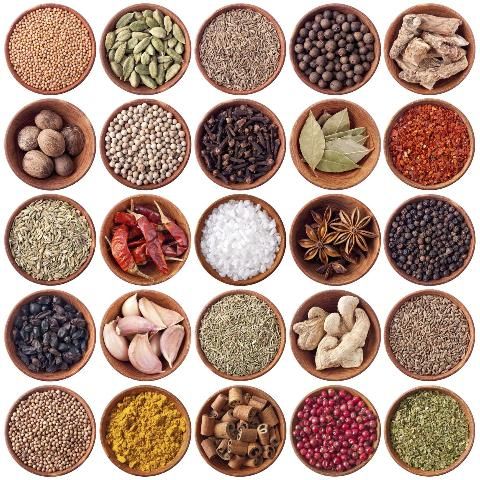Herbs and spices have been used for hundreds of years in cooking and medicine (Stephens 2010). They add a wide range of flavors to food and may also provide health benefits. Herbs and spices in cooking may help to prepare flavorful, healthy recipes.

What is the difference between herbs and spices?
People often wonder what the difference is between an herb and a spice. It simply depends on the part of the plant that is used. Herbs come from the leaves of plants that do not have woody stems and grow close to the ground in mild climates. Spices are native to warm, tropical climates and are obtained from roots, flowers, fruits, seeds, or bark. Spices tend to have a stronger and more potent flavor than herbs, so they are used in smaller amounts (Spicer 2003). Herbs and spices are commonly referred to as "seasonings" when they are used together.
Do herbs and spices have health benefits?
Perhaps the greatest health benefit of using herbs and spices is that they serve as flavorful alternatives to salt, fat, and sugar without adding any extra calories to meals. Instead of adding sugar to oatmeal, sweet potatoes, and desserts, add spices like cinnamon and allspice. For savory meals, replace salt with spices like black pepper, cumin, and dill seed. Try flavoring foods with herbs and spices instead of using breading, gravies, and sauces. Seasoning meats with herbs and spices and cooking them is a healthy alternative to breading and frying—an easy, flavorful way to reduce fat intake. Adopting changes like these can help reduce sodium, fat, and sugar in your diet.
Choosing Herbs and Spices
Certain seasonings pair better with some foods better than with others. Tables 1 and 2 list a few common herbs and spices. There are many more you can try, so be brave and experiment with your own combinations!
Should I use fresh or dried herbs?
The choice is completely up to you. Fresh herbs are not equal to dry in terms of the amounts that should be added to foods. A tablespoon of finely cut, fresh herb equals about 1 teaspoon of dried herb or ¼–½ teaspoon of ground, dried herb (Stephens 2010). In addition, fresh and dried herbs must be stored differently to ensure freshness. The tips below will help to ensure that seasonings stay fresh long after they are purchased.
Fresh
When choosing fresh herbs, avoid ones with brown or wilted leaves. Basil, cilantro, dill, oregano, parsley, thyme, and many more should be stored in the refrigerator. You can expect them to stay fresh for 2–3 weeks, although some of the flavor and aroma will be lost after the first week (Cantwell and Reid 2001). For short-term use (within a week), herbs can be refrigerated in a covered container with some water.
Frozen
To preserve herbs for an extended period, you can freeze them. To do this properly, place them on a cookie sheet and then transfer them to the freezer. Once the herbs are frozen, package them in airtight containers and store them in the freezer. Frozen herbs are limp when thawed, so it is best to use them in cooked dishes.
Dried
Dried herbs and spices never actually spoil, but their flavor and aroma fade over time. They should be stored in a cool, dry place in tight containers and away from heat. When cooking, keep the container away from steaming pots to avoid exposure to moisture (Stephens 2010). Herbs that come in large flakes, such as parsley, basil, and oregano, remain fresh for 1–3 years. Ground spices, such as paprika, cinnamon, and nutmeg, can be kept for 2–3 years. Cinnamon sticks, peppercorns, and any other whole spice can be used for up to 5 years (Dermody 2004).
Cooking with Herbs and Spices
Delicate herbs, such as basil or chives, should be added just before serving because their flavor can be lost during the cooking process. Herbs that are less delicate, such as oregano and thyme, can be added early in the process. Because the flavor of red pepper gets stronger as it is cooked, cayenne pepper should be added in small amounts to begin with, then increased as needed. Always use small amounts to start with when adding herbs and spices. For 1 pound of meat or 2 cups of soup or sauce, use ¼ teaspoon of dried ground herbs and add more if desired (Stephens 2010). When adding herbs and spices to foods that are served cold, it is important to refrigerate the food for a few hours to ensure that the flavors of the seasoning are well absorbed (Johns Hopkins Bayview Medical Center 2001).
Summary
Using herbs and spices is a great way to reduce salt, sugar, and fat in your diet while adding bold new flavors. It is a good idea to plan your meals before going to the grocery store so that you know which herbs and spices you will need. Use the advice above to keep seasonings fresh and flavorful. The examples listed above are just a snapshot of possible uses, so be creative! Follow these tips, and you will spice up your cooking in no time.
References
Cantwell M, Reid M. Herbs:(Fresh Culinary). Recommendations for maintaining postharvest quality. Perishables Handling. 2006 Jun;15.
Dermody, Cynthia. 2004. "The Shelf Life of Spices." Accessed February 18, 2022. https://www.rd.com/article/spice-shelf-life/
Spicer, Foy. 2003. "Herbs vs. Spices." Accessed January 30, 2020. https://hortnews.extension.iastate.edu/2003/8-22-2003/herbsnspices.html
Stephens, Jan. 2010. "Seasoning with Herbs and Spices." Accessed May 15, 2024. https://bookstore.ksre.ksu.edu/download/seasoning-with-herbs-and-spices_MF3539